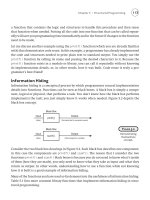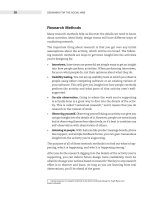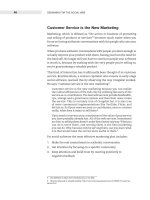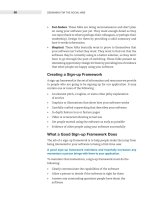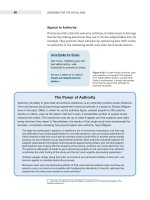designing for the social webj PHẦN 3 potx
Bạn đang xem bản rút gọn của tài liệu. Xem và tải ngay bản đầy đủ của tài liệu tại đây (7.73 MB, 20 trang )
ptg
28 DESIGNING FOR THE SOCIAL WEB
Research Methods
Many research methods help us discover the details we need to know
about activities. Most likely, design teams will have different ways of
conducting research.
The important thing about research is that you get over any initial
assumptions about the activity, which will be too broad. The follow-
ing research methods are ways to get more insight into the activities
you’re designing for:
.
Interviews. Interviews are powerful yet simple ways to get an insight
into how people perform activities. When performing interviews,
focus on what people do, not their opinions about what they do.
.
Usability testing. You can set up usability tests in which you observe
people using either competing software or an existing version of
your software. This will give you insight into how people currently
perform the activity and what parts of that activity aren’t well-
supported.
.
On-site observation. Going to where the work you’re supporting
is actually done is a great way to dive into the details of the activ-
ity. This is called “contextual research,” and it means that you do
research in the context of work.
.
Observing yourself. Observing yourself doing an activity can give you
unique insight into the details of it. However, people are notoriously
bad at observing themselves objectively, so it’s best to combine any
self-observation with observation of others.
.
Listening to people. With features like product message boards, phone
line support, and simple feedback forms, you can gain tremendous
insight into the activity you’re supporting.
The purpose of all of these research methods is to find out what is hap-
pening, why it is happening, and who it is happening among.
3
After you do the research digging into the details of the activity you’re
supporting, you can inform future design more confidently. Don’t be
afraid to change your notions based on research! The key to any research
effort is to observe and learn. As long as you are learning from real
observations, you’ll be ahead of the game.
3 A great resource on research methods is the book Contextual Design by Hugh Beyer and
Karen Holtzblatt
ptg
CHAPTER 2 A FRAMEWORK FOR SOCIAL WEB DESIGN 29
Exercise: Researching the Activity of Shopping
Let’s illustrate the value of research by doing an exercise. Let’s imagine
that you’re building software that is going to support the primary activity
of shopping. So start by writing down a description of the steps involved
in shopping. Try to answer the question: what happens when someone
shops? Don’t read further until you have your list.
Actually make the list now.
A Normal View of Shopping
In describing the activity of shopping, most people will list four or five
steps. Here is a list that I came up with off the top of my head. Let’s call
it the “normal” view of shopping.
. Recognize a need
. Consider the different choices of product that fulfills the need
. Choose a product
. Optionally, shop around for the best price
. Purchase the product
Your list w ill be slightly different, of course. But something like t his is
a basic shopping framework that most of us would come up with. Since
most of us don’t think about the activity of shopping in great detail, the
steps we describe are high-level.
An Ethnographic View of Shopping
Ethnographers are people who study human activity. They know that
you can’t trust what people say, you have to observe what they do. They
do fieldwork to understand what it is that people really do.
An ethnographer goes out into the wild and reports back. Here is what
they might report when they observe someone shopping:
We studied a woman (Betsy) who had several talks with her husband
about upgrading their TV service to HD. He was all for it, but she was
skeptical. Their conversations happened over the span of several
months. She then heard about an HD TV from a close friend who had
nothing but positive things to say. She started to seriously consider
buying one, thinking that in addition to her husband’s sports, an HD
TV sounded like a better way to watch the nature shows that her
children loved. She thought the product might be useful to her and
her family. Betsy then decided that the family’s 18-year-old TV had
had enough. She and her husband made the decision to replace their
aging TV with one of the HD TVs they heard about.
ptg
30 DESIGNING FOR THE SOCIAL WEB
The ethnographer might ask who Betsy heard about the TV from. It
was Betsy’s friend Rachel, who recommended the 40" Sony HD TV she
recently bought.
While Betsy’s husband is gung-ho, Betsy is the financial organizer of
the household. Therefore, she does much of the research on projects
like this. She starts doing research on this particular product, to
find out more about it and see if it might fit their needs and desires.
Part of her research is going online and reading about it. She goes
to Amazon.com, BestBuy.com, and Sears.com. She finds out that
there are more screen sizes, qualities, and price ranges than she
had expected. She makes a list of items that seem comparable. She
is quite confused by all the choices. This is a big hurdle for her.
Another part of her research is talking to her close friends and
other people she knows to have HD TVs, to see if they are familiar
with the one she is considering. She trusts Rachel, but Rachel tends
to recommend everything she has. Betsy wants second opinions.
Have her other friends had good or bad experiences? Would they
recommend the same TV? What other issues are there to consider?
What should she watch out for? Are there alternative brands that
she should look at?
One of Betsy’s other friends then tells her that buying the TV is only
half of the issue. The other half is getting all the gear and cables
to hook it up. Rachel hadn’t mentioned these issues. Betsy is quite
discouraged at this point. The old TV was so simple: you just plug
it in and it works.
At this point Betsy is in full research mode, with a lot of technical
information swimming about in her head that wasn’t there a week
or two ago.
Betsy and her husband think that the 40" is perfect for their needs
and they don’t want to buy a smaller one at this time. They consider
if a particular HD TV fits within their budget. They decide that it’s
more than they want to pay, so they’ll wait to see if it goes on sale.
The family waits for a couple of weeks and then receives a coupon
from Sears in the mail. They would rather pick it up than have to
pay the shipping costs. They go to a store to purchase it.
Sweat the Details
Note the extreme difference in detail between the two views. The first
view imagines a five-step, generic activity called shopping. The second
view is a whirlwind of indecision, still called shopping, but more like a
large project to find a TV that works well for the family. And, also note
that this second view is only one example of shopping. Each shopping
experience has the potential to have this much detail!
ptg
CHAPTER 2 A FRAMEWORK FOR SOCIAL WEB DESIGN 31
This second view is what most activities are like: longer than we think,
messier than we think, and with much more detail than we realize. While
not all of these details will translate directly to design, many will.
This is the value of real research into activities. It uncovers those things
we just don’t think of, but are all familiar with.
The Forgotten Element: Social Interaction
As the shopping example showed, people rarely make a decision without
involving others in some way. Though most activities are social, much
of the software designed today doesn’t take advantage of the social
interaction of the people who use it. This results from thinking about
activities in over-simplistic ways, like we did in the earlier view of the
shopping activity. What actually happens in activities is always much
more complex than our conception of it.
Identify Your Social Objects
Once you start describing activities, you’ll be struck by how big a role
objects play in them. For example, in our table above each activity we
mentioned had an associated object: movies, restaurants, projects, jobs,
photos. A huge part of our activity is managing these objects and the
social interactions that happen around them.
Social objects, as we may call the objects that mediate social activities, are
often overlooked in the excitement about social software, in particular,
social networking sites like MySpace and Facebook. Jyri Engeström, the
founder of the social messaging software Jaiku, laments that too much
focus in social design is on networking, and not the ever-present social
objects that connect us all together:
The term “social networking” makes little sense if we leave out the
objects that mediate the ties between people. Think about the object
as the reason why people affiliate with each specific other and not
just anyone. For instance, if the object is a job, it will connect me to
one set of people whereas a date will link me to a radically different
group. This is common sense but unfortunately it’s not included in
the image of the network diagram that most people imagine when
they hear the term “social network.” The fallacy is to think that
social networks are just made up of people.
4
Discovering and modeling these social objects, and our interactions in
and around them, is a major part in social design.
4 Please read Jyri’s now classic post on object-centered sociality:
blog/2005/04/why_some_social.html
ptg
32 DESIGNING FOR THE SOCIAL WEB
Real-life Artifacts
Sometimes, you can even model real-life artifacts as objects in your design.
Here are three that have replicated a physical object in software:
.
Facebook. The Facebook is an actual book given out to Harvard
students containing pictures and bios of all incoming freshmen, so
they can enjoy finding out about their new classmates.
.
Amazon’s Wish List. Amazon’s wish list is modeled after actual
wish lists that people make and share with others.
. Remember the Milk. Remember the Milk is a list management tool
that models the lists we make as we head out to do some shopping
or roll up our sleeves to begin our chores.
Funky Objects
Social objects within your web application don’t have to be exact rep-
resentations of physical objects (like videos, photos, or dogs). They can
be abstract.
For example, jobs and dates—the two objects Engeström mentions—are
not physical in the sense that a table is, yet we easily deal with them on
Proven Success of Social Objects
The most successful web applications are built around social objects. Consider the following
list of services. All the interactions on these sites happen in and around very specifi c social
objects:
Flickr—Photos
Amazon—Products
(e.g. books)
YouTube—Videos
Upcoming—Events
Twitter —Messages
Del.icio.us—Bookmarks
eBay—Auction items
Craigslist—Classifi eds
Last.fm—Music
Digg—News stories
Dogster—Dogs
Blogger—Blogs
Monster—Jobs
Netflix—Movies
Slideshare—Presentations
Wikipedia—Encyclopedia
entries
As we can see, social objects are really the starting point of a lot of social web applications.
They are the objects around which many of our activities revolve. Identifying these objects is
crucial to designing for them.
ptg
CHAPTER 2 A FRAMEWORK FOR SOCIAL WEB DESIGN 33
a daily basis. Projects and events are also abstract, but we organize our
activities around them effortlessly.
What’s important is not that you have a single, physical object to focus
on, but that you focus on a social object in the same way the people who
use your software do. If people are organizing around funky objects like
projects, then that’s an object you can design for.
Give the Social Objects a URL
To demonstrate the proven success of social objects earlier in this chap-
ter, I listed a number of services that contain unique objects. There are
distinct advantages to giving an object a URL:
. URLs make objects sharable
. URLs make objects easier to find and re-find
. URLs allow people to link to the object directly
. Search engines like URLs
Flickr’s URLization of Photos
The success of the photo-sharing site Flickr is tied closely with their
decision to give photos a unique URL. Team member Eric Costello
describes their transition from allowing people to share photos over
chat to allowing people to archive photos at a URL.
Before URLs:
When we first launched Flickr, it was a Flash application that was
mainly just a chat environment with real-time photo sharing. So it
was quite limited in what you could do.
It wasn’t a photo sharing site, so much as it was a place where you
could go to chat and talk about photos. But none of that activity was
stored in any asynchronous way.
After URLs:
As we started adding features to the site itself, like pages that hosted
the photos so that people could visit them at a unique URL, we had
a lot more success with that. People responded to it, and the site
began to grow.
5
5 />ptg
34 DESIGNING FOR THE SOCIAL WEB
So once Flickr identified photos as their object and gave them a unique
URL, their service started taking off. This makes sense: objects are
unique, and giving them a unique URL allows people to treat them
like freestanding objects. Once photos had a unique URL, they became
addressable by anyone and everyone.
Choose a Core Feature Set
After identifying the primary activity and the objects people interact
with, you’re ready to start creating your core feature set. Your core feature
set is the set of possible actions that people can do in your application.
They define what activity goes on, the possible interactions between
people, what can and—sometimes just as importantly—cannot occur.
Choosing features is one of the most important steps in defining what
a web site is going to be.
Finding Your Verbs
In the beginning of this chapter we mentioned feature creep, the
disease that afflicts so many design projects. So how do you avoid
feature creep when creating and adding features? Start with your
objects, your nouns. Observe all the actions people do with/perform
on those objects, and those are possible features for your application.
Jyri Engeström calls this step “finding your verbs.” Given a noun, what
actions are associated? The answer, as our high school English teachers
would point out, is indeed a list of verbs.
Here are some examples of finding verbs:
Nouns (objects) Verbs (actions)
Videos play, stop, edit, store, upload, share, comment on,
embed in blog
Articles read, archive for later, quote, link to, share, comment on,
annotate
Photos store, view, add to favorites, digitally edit, link to, make
prints, share, comment on, embed in blogs, tag
Books read, add to cart, purchase, add to wish list, share, add to
wedding registry, comment on, rate, tag, discuss, review
ptg
CHAPTER 2 A FRAMEWORK FOR SOCIAL WEB DESIGN 35
Many of these verbs translate directly into features. If you’re building
a video site, for example, you’ll likely have features to upload a video,
play the video, and share the video. This simple step is where the most
valuable features come from!
Also, notice that the verbs are both personal and social. This is to be
expected, as we interact with objects both on a personal level and a
social level.
Figure 2.2 The entire YouTube interface is made up of objects (nouns) and the actions
you can perform on them (verbs). If you take the nouns and verbs off the page, there is
very little, if anything, left.
Video Object
Verbs
play/pause
share
add to favorites
add to playlist
fl a g
rate
post a response
add comment
embed
upload
Response
Object
Comments
Object
Person Object
Verbs
view
subscribe
Related Objects
Verbs
view
add to Quicklist
ptg
36 DESIGNING FOR THE SOCIAL WEB
Collections of Objects as Features
Pay attention to any collections of objects. They can often become valu-
able features. One important collection is lists. Are people making lists?
What of? How are they organizing and managing information? Here are
some common ways that people collect things:
. Wish lists
. Shopping carts
. Favorites
. Shared items
. My stuff (restaurants, reviews,
bookmarks, etc.)
. Friend’s stuff
. Projects
Once you have an idea of the collections that people make, give them
ways to manage the collection. What actions (verbs) do they perform
on the collection? This will probably mean providing people with ways
to add, edit, and delete items from the collection, and perhaps even
treating the collection as an object itself, with features such as sharing
and a permalink.
Amazon’s Social Features
Let’s explore the social features on the Amazon site in light of the AOF
method. As you can see, Amazon has a tremendous number of social
features to help make shopping easier.
Figure 2.3 Amazon has
an amazing array of social
features. Getting to this point
takes in-depth observation of
the social interaction in and
around shopping.
Product ratings
Share your own
product images
People who bought this
also bought
Add to Wish/
Shopping List
Add to Wedding/
Baby Registry
Tell a friend
ptg
CHAPTER 2 A FRAMEWORK FOR SOCIAL WEB DESIGN 37
Amazon sales rank
Popular in these categories
Update Product Info
Give feedback on images
What do customers ultimately
buy after viewing this item?
Tag this item
Help others fi nd this item
Sell yours here
Rate this item to improve your
recommendations
Customer Reviews
Was this review helpful to you?
ptg
38 DESIGNING FOR THE SOCIAL WEB
Report this
Create your own review
Start a new discussion
Listmania
So you’d like to
We can see that most of the actions support the most important object,
the product. Amazon has focused most of their time and energy there.
But they have also identified other important objects central to the
activity of shopping, and include features to support those.
If we were designing with a common-sense notion of shopping, without
doing any research, we would design a very different web site than we
would with an ethnographer’s detailed study in our hands. It would be
difficult to come up with the social features at Amazon from team meet-
ings and common sense. It is only by paying close attention to how people
shop, the reasons why they make lists, their heavy reliance on customer
reviews, and their tendency to look at sales numbers, that we would be
able to come up with these interface features. Sweat the details!
Once you start thinking about features as actions to be done on objects,
it becomes clear how the most successful services figure out which
features to add. They simply answer the question: What are people doing
with the objects?
The table that follows looks at Amazon’s core features in this way.
ptg
CHAPTER 2 A FRAMEWORK FOR SOCIAL WEB DESIGN 39
Objects Social Features (actions)
Products Rate product
Tag prod uc t
Review product
Customers who bought this also bought
Submit a product manual
Tel l a fri en d
Share product images
Amazon sales rank
Add to cart
Wish list Add items
Create new list
Share list
Make public/private
Sort list
Customer reviews Add review
Comment on review
Was this review helpful?
Sort reviews
Keeping a Check on Features
As we have noted, features can get out of hand quickly. Here are a few
guidelines to keep in mind when designing that help you deal with
features reasonably.
Each Feature Means More Complexity
There is no way around it: each feature in your web site adds com-
plexity. The process of introducing it, shifting other things around,
re-prioritizing things is complex. When this is done well, people adapt
quickly. When this is done poorly, the interface becomes more complex
and you start hearing complaints.
Just Say No
One way to counteract adding too many features is to simply say “No”
to them. Accept only the most important features, and keep the others
on the back burner until they are truly necessary.
ptg
40 DESIGNING FOR THE SOCIAL WEB
There is a great story about the building of iTunes that applies here. Steve
Jobs was talking to music industry people about the direction the soft-
ware was going. They had all sorts of ideas for what the software could
possibly do. After a while Steve got tired of the queries, and said:
I know you have a thousand ideas for all the cool features iTunes
*could* have. So do we. But we don’t want a thousand features. That
would be ugly. Innovation is not about saying yes to everything. It’s
about saying NO to all but the most crucial features.
6
Don’t Copy Features!!!
One client I worked with would copy features that looked useful from
their competitors. They said they didn’t have time to fully research
features themselves. Later, I ended up speaking with someone from
the design team of that competitor, and it turns out they did the same
thing! They simply copied their features from somewhere else!
The Emerson quote at the beginning of this chapter is relevant here.
It’s easy to simply copy features when everyone is looking at you. Your
site looks like everyone else’s and people assume you know what you’re
doing. It’s also easy to go your own way when nobody is looking at you.
But it is the most difficult (yet most successful) when you can do your
own research and innovate in the face of scrutiny. That’s why the best
designs stand out…because they go their own way.
Conclusion
At some point all design teams struggle with a lack of focus. There are
many reasons why. It helps to have a prioritization scheme like the
Activities, Objects, Features method (AOF) to keep things focused. By
keeping an eye on the primary activity and the objects related to it,
designers can come up with a robust feature set that really does support
what people are trying to do.
But as exciting as it is to get features in place, it is only the beginning
of the battle in creating a social web site. You still have to motivate
people to actually use the features you’ve created! That’s what we
cover in the rest of the book, focusing on the major hurdles of usage
that affect all projects.
6 />ptg
41
3
Authentic
Conversations
Why having authentic conversations
is the most important thing you
can do for your social web site
The long silence—the industrial interruption of the human
conversation—is coming to an end. On the Internet, markets
are getting more connected and more powerfully vocal every
day. These markets want to talk, just as they did for the thou-
sands of years that passed before market became a verb with
us as its object.”
— The Cluetrain Manifesto
“
ptg
42 DESIGNING FOR THE SOCIAL WEB
On June 21, 2005, noted media industry veteran Jeff Jarvis was having
a bad time with his Dell laptop. He was having an even worse time
with the service he was receiving from the computer company. He had
bought an expensive warranty that he felt Dell wasn’t honoring, and
he was getting the runaround on the phone. Jeff decided to vent his
frustrations by posting them on his blog
1
for all to see:
Figure 3.1 The original post from Jeff Jarvis that started the Dell Hell series on his blog.
Ten years ago, the only way this information would have been made
public is through whatever effort Jeff could make to tell his friends or
perhaps write a letter to the editor. Maybe a reporter would have picked
it up and written a story about it. Either way, the audience who would
have seen it would have been relatively small. But, in the age of blogging,
Jeff’s story was available for everyone to see, 24 hours a day, 365 days a
year, right on Jeff’s web site. Jeff called his situation “Dell Hell.”
Over the following weeks, Jeff continued to be unhappy with the ser-
vice from the company, and continued to post his frustrations on his
blog. Pretty soon others had picked up on his plight and joined him in
a chorus of hatred for Dell. Hundreds and hundreds of people left com-
ments on his blog.
It turns out that Jeff’s situation wasn’t isolated. Many other people
felt strongly that the company was providing poor service. In fact,
some bloggers directed Jeff’s attention to similar posts they had made
in the months and years prior to his post about bad service from Dell.
1 />ptg
CHAPTER 3 AUTHENTIC CONVERSATIONS 43
At this point Dell—already aware of how upset people were with their
service—had a choice. Would they engage with Jeff and other people who
voiced their opinion, or would they leave it be and hope it went away?
Up until that point, Dell had a “look, don’t touch” policy, observing stories
like this from afar, but not responding in any way.
2
Would they change
that policy in the face of mass public scrutiny?
Much to its own detriment, Dell continued its silence. The story of Dell
Hell grew bigger. Dozens of blogs picked up on it, and news outlets too.
The negative story about Dell’s support spread far and wide.
The Growing Alienation
Dell is by no means alone in their disengagement. Our frustration with
corporations is at an all-time high. The very companies we entrust
with our business are ignoring us, even though we, the customers, are
the reason for their success. And worst of all, we’re so used to it that
we seem to accept it as a matter of course. I was reminded of this the
other day after spending forty minutes on hold with my web-hosting
provider, and coming out of it not the least bit surprised. I realized with
self-loathing that I accepted this as par for the course when dealing with
companies. Did they not think my time was important? Did they care? If
they cared, I had no evidence of it. And, as Jeff’s situation made perfectly
clear, countless people are experiencing this alienation every day.
Doc Searls, in The Cluetrain Manifesto, describes this alienation:
In the twentieth century, the rise of mass communications media
enhanced industry’s ability to address even larger markets with no
loss of shoe leather, and mass marketing truly came into its own.
With larger markets came larger rewards, and larger rewards had
to be protected. More bureaucracy, more hierarchy, and more com-
mand and control meant the customer who looked you in the eye
was promptly escorted out of the building by security.
3
2 />3 />ptg
44 DESIGNING FOR THE SOCIAL WEB
People Who Build Web Applications
are Especially Vulnerable
If you’re building a web application, you are especially vulnerable to
this growing alienation, for several reasons:
. No face-to-face contact. It is unlikely that you will see any of the
people who use your software face-to-face. Therefore, it is important
to reach out and have conversations over social software. This kind
of interaction is slightly harder because the nuance of interpersonal
communication is lost.
.
Frustration is invisible. Unless someone makes the effort to tell
you when something goes wrong, you won’t know when prob-
lems arise. They may languish in their own frustration until they
give up or complain in some other way, like Jeff and others did on
their blogs.
. Support is part of the product. To the people who use your software,
there is little distinction between the application and the support
you provide for it. Web-based software isn’t so much a product as it
is a service. The service—including the quality of support and other
interactions—is the value you deliver, and thus quality customer
relations are crucial.
What Could it Look Like?
Dell’s choice to not engage Jeff in conversation was a poor one. It would
have been a poor decision even if Jeff was not well known with a big
audience. It was a poor decision simply because he was a customer at
all. Every day, Dell was ignoring the frustration of the people who made
and could continue to keep them successful.
But it doesn’t have to be this way. Consider the reply on Christina
Wodtke’s blog
4
after she posted concerns about Plaxo’s privacy policy
concerning emailing contacts. (Plaxo is an online contact manager and
Christina is the tech editor of this book.) The message left by Stacy
Martin, the Privacy Officer at Plaxo, serves as a wonderful example of
how you can engage with people, address their concerns, and make
them feel heard.
4 Christina’s blog can be found at />ptg
CHAPTER 3 AUTHENTIC CONVERSATIONS 45
Notice that Stacy does several things well in this message. First, by
using his real name and position at the company, he instantly estab-
lishes his credibility. Second, he addresses Christina’s concerns directly,
acknowledging (without actually knowing) that something wrong may
have occurred. He asks Christina to contact him directly to address
Christina’s specific situation. He also explains Plaxo’s general philoso-
phy on sharing information, which informs others who read the blog
that Plaxo is serious about privacy. He doesn’t argue or get upset. He
is authentic.
Figure 3.2 Christina Wodtke posts about an issue she had with Plaxo, an online contact
manager. Note that she updated the post to make sure that people read the comment
from the Plaxo representative. Authentic conversations work like that.
Figure 3.3 A wonderful example of how customer service on the web can work.
ptg
46 DESIGNING FOR THE SOCIAL WEB
The Value of Authentic
Conversation
What Dell should have done, of course, is simply have a conversation
with Jeff and his readers, just like Stacy of Plaxo did with Christina. This
would have been easy for Dell to do: the company has thousands of
employees and a large marketing group. A single employee could have
quelled this uprising by simply engaging in conversation.
But engaging in authentic conversations isn’t just about quelling nega-
tive sentiment from frustrated customers. That frustration is simply a
symptom of not engaging.
The long-term benefits of actively engaging—happier people and better
software—vastly exceed the short-term pain from negative press.
Happier People
Having authentic conversations with the people who use your software
is a win-win situation. It drives the following advantages:
. Recognition that you care. When you have authentic conversations
with people, you show that you care about their situation. Whatever
the reality, Dell’s lack of outreach gave Jeff Jarvis the feeling that
Dell didn’t care. When you start having conversations with people,
they’ll give you the benefit of the doubt.
.
Awareness and interest. You’ll also gain awareness and interest
in your software. This happens because people respond to and act
favorably toward those who talk to them. This isn’t supposed to be
magic. It’s a core principle of human communication. So as you pay
attention to people and respond to their needs, they’ll start paying
more attention to you as well. The relationship thus grows stronger,
benefitting both sides.
Figure 3.4 Getting people
interested in your software doesn’t
happen overnight. It’s more like an
evolving relationship that relies on
authentic conversation.
Unaware Interested
Awareness
ptg
CHAPTER 3 AUTHENTIC CONVERSATIONS 47
Better Software
The counter-intuitive part of having authentic conversations is how they
can actually lead to better software. In other words, having authentic
conversations actually helps you design!
. Ear to the ground. When you have conversations with people, you
have a much better sense of what’s going on and can react much
more quickly should a problem arise.
.
More design data. Having conversations allows you to gather much
more information to inform your design. This will lower the cost of
other research methods.
. Passionate feedback. Until you’ve met passionate users, it’s hard to
imagine how much feedback they’ll gladly give you about your soft-
ware. I remember the first time I encountered passionate users—it
was a chore just to record all of their feedback.
. Users as inventors. Not only do people provide great feedback, but
they also become co-inventors. Look no further than the open-source
movement for passionate users who get involved in building the
product itself.
The Trick of Authenticity
Client: This sounds great! I can get awareness and interest, find out
what people think, and get people connected to my company. Sign me up
for this authentic conversation feature.
Me: Well… there is one more thing.
Client: What’s that?
Me: You have to mean it.


